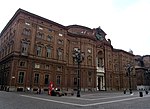Museum of the Risorgimento (Turin)
1878 establishments in ItalyItalian museum stubsLocation maps with marks outside map and outside parameter not setMuseums established in 1878Museums in Turin ... and 2 more
Museums of the Italian unificationNational museums of Italy

The National Museum of the Italian Risorgimento (Italian: Museo nazionale del Risorgimento italiano) is the first, the biggest and the most important among the 23 museums in Italy dedicated to the Risorgimento; and the only one which can be considered "national" according to a 1901 law, and due to its rich and great collections. It is housed in the Palazzo Carignano in Turin.
Excerpt from the Wikipedia article Museum of the Risorgimento (Turin) (License: CC BY-SA 3.0, Authors, Images).Museum of the Risorgimento (Turin)
Via Cesare Battisti, Turin Centro
Geographical coordinates (GPS) Address Phone number Website Nearby Places Show on map
Geographical coordinates (GPS)
| Latitude | Longitude |
|---|---|
| N 45.0688 ° | E 7.6859 ° |
Address
Palazzo Carignano
Via Cesare Battisti
10123 Turin, Centro
Piedmont, Italy
Open on Google Maps










